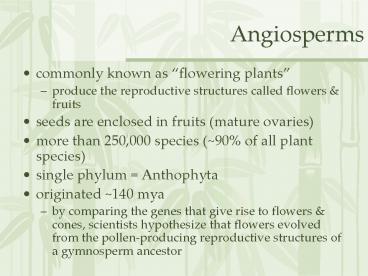Angiosperms - PowerPoint PPT Presentation
1 / 10
Title:
Angiosperms
Description:
seeds are enclosed in fruits (mature ovaries) ... by comparing the genes that give rise to ... can have up to 4 rings of modified leaves called floral organs: ... – PowerPoint PPT presentation
Number of Views:57
Avg rating:3.0/5.0
Title: Angiosperms
1
Angiosperms
- commonly known as flowering plants
- produce the reproductive structures called
flowers fruits - seeds are enclosed in fruits (mature ovaries)
- more than 250,000 species (90 of all plant
species) - single phylum Anthophyta
- originated 140 mya
- by comparing the genes that give rise to flowers
cones, scientists hypothesize that flowers
evolved from the pollen-producing reproductive
structures of a gymnosperm ancestor
2
Flowers
- specialized for sexual reproduction
- can have up to 4 rings of modified leaves called
floral organs - sepals enclose the flower before it opens
- petals aid in attracting pollinators
- stamens produce microspores which give rise to
pollen grains containing male gametophytes - carpels make megaspores which produce the
female gametophytes
3
Fruits
- consists of seeds (fertilized ovules) in a mature
ovary - protect dormant seeds aid in their dispersal
- can be fleshy or dry
- can be dispersed via
- wind
- animals (burrs through digestive tract)
4
Angiosperm Life Cycle
- flowers on mature sporophyte produce microspores
and megaspores - microspores develop into pollen grains, which
contain two haploid cells - generative cell (divides into 2 sperm)
- tube cell (produces a pollen tube)
- megaspores are located in ovules and develop into
the female gametophyte (embryo sac) consisting of
a few cells, one of which is the egg - pollination occurs when a pollen grain reaches
the sticky stigma at the tip of a carpel
germinates - many flowers have mechanisms to ensure
cross-pollination - the pollen tube grows down the style to the ovary
where it penetrates the micropyle of an ovule
discharges two sperm cells into the embryo sac
5
Angiosperm Life Cycle cont.
- double fertilization
- one of the sperm cells fertilizes the egg forming
a diploid zygote which develops into a sporophyte
embryo with a rudimentary root 1-2 seed leaves
called cotyledons - the other sperm cell fuses with the two polar
nuclei in the large central cell of the embryo
sac forming a triploid cell that develops into
endosperm (tissue rich in starch other food
reserves) - as the ovules mature into seeds, the ovary
develops into a fruit - seeds germinate when environmental conditions are
favorable - the seed coat ruptures and the embryo emerges as
a seedling, using food stored in the endosperm
cotyledons
6
Comparison of Gymnosperm Angiosperm Life Cycles
7
Angiosperm Diversity
- basal angiosperms three clades that consist of
plants belonging to the oldest lineages - magnolids share some primitive traits with the
basal angiosperms but are more closely related to
monocots eudicots - monocots
- eudicots
see next slide
8
Monocots Eudicots
- more than ¼ of angiosperm species are monocots
(70,000 sp.) - more than ? of angiosperm species are eudicots
(170,000 sp.)
9
Coevolution betweenAngiosperms Animals
- animals crawling on the forest floor probably
influenced the evolution of plants keeping their
spores gametophytes off the ground this, in
turn, may have influenced the evolution of flight
in insects - plant-pollinator relationships have evolved
together - angiosperm evolution has contributed to insect
diversity
10
Significance of Plants
- provide habitats food for animals
- provide food for humans
- 6 angiosperms (wheat, rice, maize, potatoes,
cassava, sweet potatoes) yield 80 of all
calories consumed by humans - non-staples like coffee, tea, spices
- produce O2
- source of fuel
- source of wood
- source of medicines































